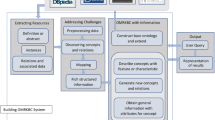Abstract
Merging new instance knowledge extracted from the Web according to certain domain ontology into the knowledge base (KB for short) is essential for the knowledge management and should be processed carefully, since this may introduce redundant or contradictory knowledge, and the quality of the knowledge in the KB, which is very important for a knowledge-based system to provide users high quality services, will suffer from such “bad” knowledge. Advocates a property restriction based knowledge merging method, it can identify the equivalent instances, redundant or contradictory knowledge according to the property restrictions defined in the domain ontology and can consolidate the knowledge about equivalent instances and discard the redundancy and conflict to keep the KB compact and consistent. This knowledge merging method has been used in a semantic-based search engine project: CRAB and the effect is satisfactory.
Preview
Unable to display preview. Download preview PDF.
Similar content being viewed by others
References
Aidan, H., Andreas, H., Stefan, D.: Performing Object Consolidation on the Semantic Web Data Graph. In: WWW 2007 Workshop on Entity-Centric Approaches to Information and Knowledge Management on the Web, Banff, Canada (2007), http://ftp.informatik.rwth-aachen.de/Publications/CEUR-WS/Vol-249/submission_135.pdf
Brickley D.: Rdfweb notebook: aggregation strategies (2002), http://rdfweb.org/2001/01/design/smush.html
Sais, F., Pernelle, N., Rousset, M.C.: L2R: a logical method for reference reconciliation. In: 22nd AAAI Conference on Artificial Intelligence, Vancouver, BC, Canada, pp. 329–334 (2007)
Che, H., Sun, J., Bai, X., Shi, L.: Application of aggregated knowledge concept in automatic knowledge acquisition from Chinese web pages. In: 2008 International Symposium on Information Processing, Moscow, Russia, pp. 439–443 (2008)
Che, H., Sun, J., Jing, T., Bai, X.: A prototype of semantic-based intelligent search engine for Chinese documents. In: 4th International Conference on Fuzzy System and Knowledge Discovery, Haikou, Wuhan, China, pp. 663–667 (2007)
Author information
Authors and Affiliations
Editor information
Editors and Affiliations
Rights and permissions
Copyright information
© 2009 Springer-Verlag Berlin Heidelberg
About this paper
Cite this paper
Che, H., Chen, W., Feng, T., Zhang, J. (2009). A Property Restriction Based Knowledge Merging Method. In: Liu, W., Luo, X., Wang, F.L., Lei, J. (eds) Web Information Systems and Mining. WISM 2009. Lecture Notes in Computer Science, vol 5854. Springer, Berlin, Heidelberg. https://doi.org/10.1007/978-3-642-05250-7_5
Download citation
DOI: https://doi.org/10.1007/978-3-642-05250-7_5
Publisher Name: Springer, Berlin, Heidelberg
Print ISBN: 978-3-642-05249-1
Online ISBN: 978-3-642-05250-7
eBook Packages: Computer ScienceComputer Science (R0)




